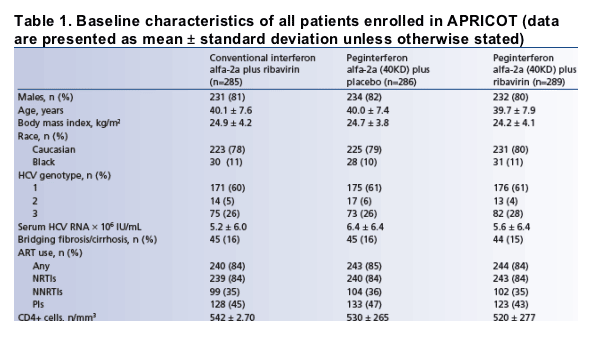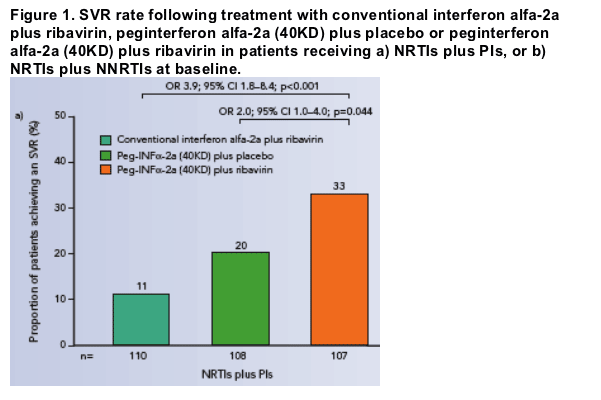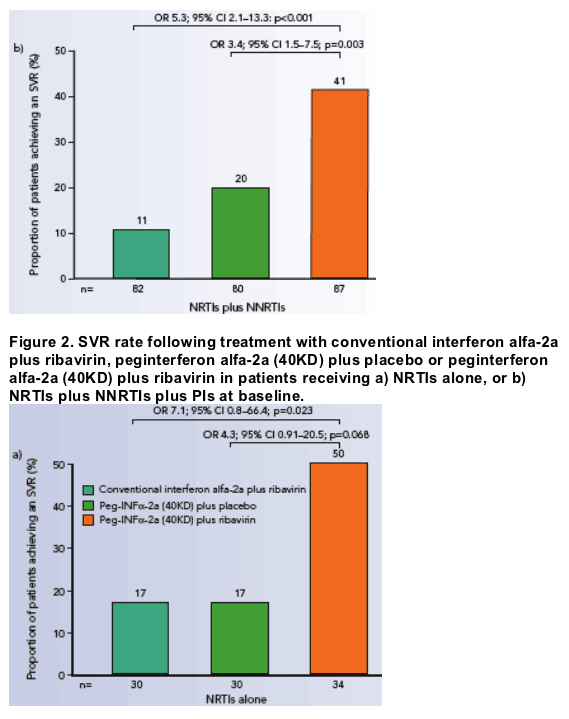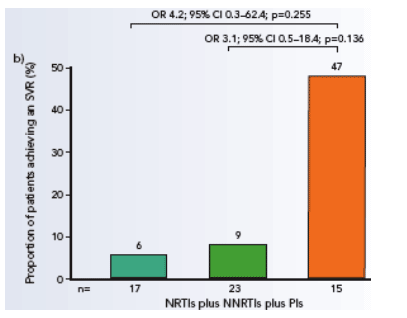 |
 |
 |
| |
HAART & SVR in APRICOT Study
|
| |
| |
Sustained virological response to peginterferon alfa-2a (40KD) (PEGASYS) plus ribavirin (COPEGUS) in HIV-HCV co-infected patients according to antiretroviral therapy in the AIDS PEGASYS Ribavirin International Co-infection Trial (APRICOT)
Presented at the 10th European AIDS Conference: 2005 November 17-20: Dublin, Ireland.
F.J. Torriani,1 C. Katlama,2 M. Sulkowski,3 G. Dore,4 D. Cooper,5 D. Dieterich,6 Y. Benhamou7
1University of California, San Diego, CA, USA; 2Goupe Hospitalier de la Pitie Salpetriere, Paris, France; 3Johns Hopkins University, Baltimore, MD, USA;
4University of New South Wales, Sydney, NSW, Australia; 5St. Vincent's Hospital, Sydney, NSW, Australia; 6Mount Sinai School of Medicine, New York, NY, USA; 7Groupe Hospitalier Pitie-Salpetriere, Paris, France
This research was funded by Roche, Basel, Switzerland.
The combination of a pegylated interferon plus ribavirin is the treatment of choice for chronic hepatitis C patients co-infected with human immunodeficiency virus (HIV).[1] Treatment with peginterferon alfa-2a (40KD) (PEGASYS) plus
ribavirin (COPEGUS) produced significantly higher sustained virological response (SVR) rates than peginterferon alfa-2a (40KD) monotherapy or conventional interferon alfa-2a plus ribavirin (40% vs 20% and 12%, respectively; p<0.001) in APRICOT,[2] the largest international trial of anti-hepatitis C
virus (HCV) therapy in patients with HIV-HCV co-infection. The use of antiretroviral therapy (ART) in APRICOT was not mandated but approximately 85% of all patients included were receiving ART at baseline.
STUDY OBJECTIVE:
We examined the relationship between SVR rates and the use of common combinations of ART drug classes at baseline in patients with HIV-HCV co-infection enrolled in APRICOT.
AUTHOR CONCLUSIONS
SVR rates with peginterferon alfa-2a (40KD) (PEGASYS) plus ribavirin (COPEGUS) were higher than those with peginterferon alfa-2a (40KD) monotherapy or conventional interferon alfa-2a plus ribavirin, regardless of ART use at baseline, in patients with HIV-HCV co-infection in APRICOT.
SVR rates with peginterferon alfa-2a (40KD) plus ribavirin did not appear to be different in patients receiving different combinations of the three most used ART drug classes at baseline.
SVR rates in patients treated with peginterferon alfa-2a (40KD) plus ribavirin were similar in patients who were and were not receiving ART at baseline (39% vs 44%), suggesting that, in populations with preserved cellular immunity (high CD4+ counts), further control of HIV replication with ART does not have a significant effect on HCV virological outcome.
STUDY DESIGN
Patients were randomised to receive 48 weeks of treatment with peginterferon alfa-2a (40KD) 180 _g/week plus either ribavirin 800 mg/day or placebo, or conventional interferon alfa-2a 3 MIU three times weekly plus ribavirin 800 mg/day.
The primary end-point of APRICOT was SVR, defined as undetectable serum HCV RNA (<50 IU/mL) by qualitative polymerase chain reaction assay (COBAS AMPLICOR HCV Monitor Test, v2.0), at the end of a 24-week untreated
follow-up period (week 72).
In this analysis, patients with an SVR were grouped according to the use of common combinations of ART drug classes at baseline: nucleoside reverse-transcriptase inhibitors (NRTIs) plus protease inhibitors (PIs); NRTIs plus non-NRTIs (NNRTIs); NRTIs alone; or NRTIs plus NNRTIs plus PIs.
Statistical Analysis: Differences in SVR rates were assessed by Cochran-Mantel-Haenszel test stratified by geographical region, HCV genotype and CD4+ cell count.
RESULTS
A total of 868 patients were randomised to treatment in APRICOT; of these, 860 received study medication. Baseline characteristics of all treated patients are shown in Table 1.
A total of 84%, 85% and 84% of patients randomised to conventional interferon alfa-2a plus ribavirin, peginterferon alfa-2a (40KD) plus placebo and peginterferon alfa-2a (40KD) plus ribavirin, respectively, were receiving ART at baseline.
The majority of patients receiving ART at baseline in all three treatment groups were taking NRTIs in combination with a PI or an NNRTI.
SVR rates in patients receiving peginterferon alfa-2a (40KD) plus ribavirin were consistently higher than those in patients receiving peginterferon alfa-2a (40KD) monotherapy or conventional interferon alfa-2a plus ribavirin, regardless of
the type of ART drug class combination used at baseline (Figures 1 and 2).
Although the proportion of peginterferon alfa-2a (40KD) plus ribavirin recipients using NRTIs + NNRTIs who achieved an SVR was higher than that in peginterferon alfa-2a (40KD) plus ribavirin recipients using NRTIs + PIs (41% vs 33%) (Figure 1b and 1a), this difference was not statistically significant (odds ratio [OR] 1.45; 95% CI 0.81-2.61; p=0.214).
In patients treated with peginterferon alfa-2a (40KD) plus ribavirin, SVR rates were similar between patients who were and were not receiving ART at baseline (Figure 3).

Again, authors concluded that this data "suggest that, in populations with preserved cellular immunity (high CD4+ counts), further control of HIV replication with ART does not have a significant effect on HCV virological outcome".




References
1. Alberti A, Clumeck N, Collins S, et al. Short statement of the first European consensus conference on the treatment of chronic hepatitis B and C in HIV co-infected patients. Hepatology 2005; 42: 615-24
2. Torriani FJ, Rodriguez-Torres M, Rockstroh JK, et al. Peginterferon alfa-2a plus ribavirin for chronic hepatitis C virus infection in HIV-infected patients. N Engl J Med 2004; 351 (5): 438-50
|
|
| |
| |
|
 |
 |
|
|